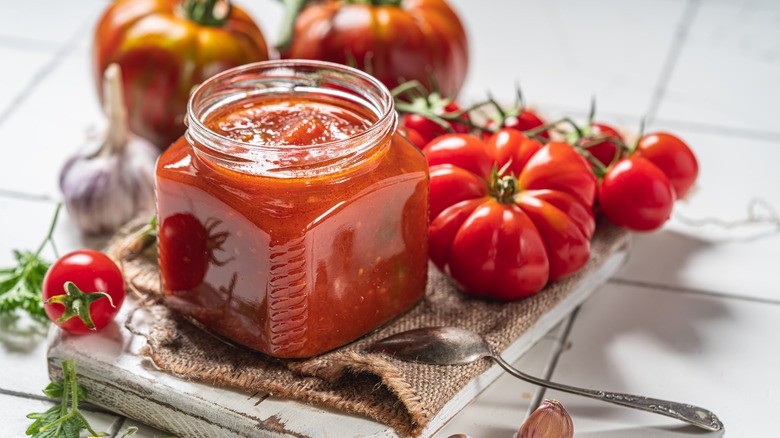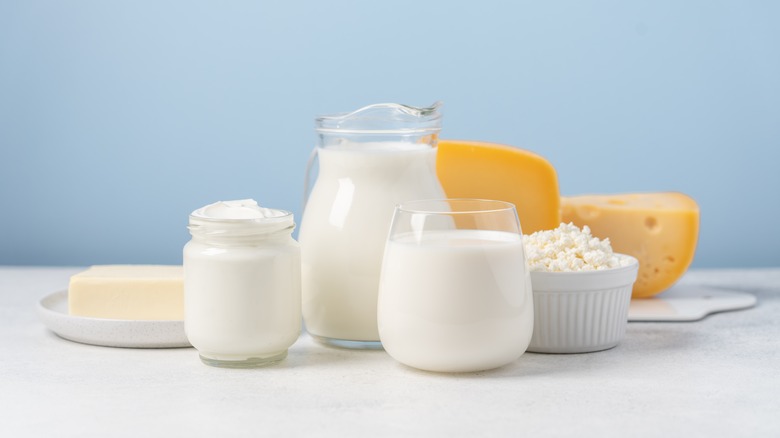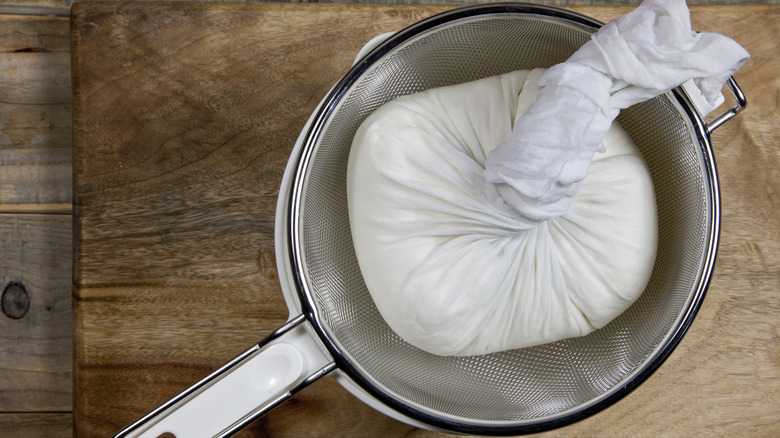The Key To Making Homemade Condiments Last Longer
For those looking to banish bland and boring food from the table, a good arsenal of condiments is a necessity. Really want to up the ante? Make them at home.
Avoid the pitfalls of store-bought condiments (namely the large quantities of added sugar, as well as cost) by making them from scratch. It's a fun, fulfilling pursuit, and homemade condiments also allow for complete customization. Change up the chilis in a batch of hot sauce recipe to suit a specific spice level, or kick up homemade ketchup with a dash of curry powder.
If there's one downside to making condiments in a home kitchen, it's this: They won't last as their store-bought counterparts. Of course, this is due to avoiding artificial preservatives and extensive processing, which is a good problem. But, it can nonetheless be frustrating to put effort into a homemade condiment just to have it spoil after a week. Fortunately, there's a solution to this problem.
Homemade condiments can be made to last for months by culturing them. Culturing is a preservation method that uses a starter culture — a collection of beneficial microorganisms — to ferment foods. The easiest way to make a starter culture is to separate the whey from a container of plain yogurt. Then, mix a few tablespoons of that whey into the homemade condiment. The bacteria within the whey will preserve the finished product, thanks to the magic of lacto-fermentation.
How lacto-fermentation works
Fermentation is perhaps the oldest method of food preservation, and it's one of the best examples of chemistry at work in the kitchen. In fermentation, microorganisms such as bacteria, yeast, or fungi break down the natural sugars in a food and convert them into acid or alcohol, which prevent dangerous molds and bacteria from growing.
Lacto-fermentation is a particular method that uses Lactobacillus bacteria to convert sugars into lactic acid. It also reduces the amount of oxygen in foods, making it impossible for most dangerous microorganisms to survive. The notion of fighting bacterial growth with bacteria might sound strange, but Lactobacillus are present in most animals, including humans, and they are great for gut health. Lacto-fermentation is one of the most prevalent forms of fermentation, used in foods such as pickles, sauerkraut, kimchi, and sourdough bread.
Yogurt is also made through lacto-fermentation, which is why it can be used to make a starter culture. You might have noticed that, with certain types of plain yogurt, a layer of hazy yellowish liquid will collect at the top of the container. This is whey, one of the proteins found in milk. Specifically, it is acid whey, the byproduct of curdling milk to make yogurt or cheese. You can isolate whey by straining it out of yogurt, and then use it to lacto-ferment condiments, or just about anything else.
How to preserve condiments using yogurt whey
You need to start with the right kind of yogurt. It has to be plain, organic yogurt with active bacterial cultures. You cannot use yogurt with any flavorings or other additives. You should also avoid Greek yogurt, as it usually has the whey strained out of it already. Once you've got your plain, organic yogurt, you're ready to extract the whey, for which you'll need a sieve, a bowl, and some cheesecloth.
Line the sieve with cheesecloth and place it over the bowl. Then, pour in a whole tub of yogurt. The whey will gradually drip down into the bowl. This takes around eight hours at room temperature, or 24 hours in the fridge. Once you've separated the whey, you can put the yogurt back in its tub to eat as normal. The whey can be kept in the fridge for months.
When you have some homemade condiments you'd like to preserve, simply follow the normal recipe, then add a few tablespoons of whey to the finished product. Stir it in, then pour the condiment into a jar and seal it tightly. Leave this out at room temperature for two days if the weather is hot, up to four days if the weather is cold. This gives the bacteria time to ferment the food. Once the time is up, place that jar in the fridge, and it will keep for up to three months. Best of all, this method won't alter the flavor of your condiments.


